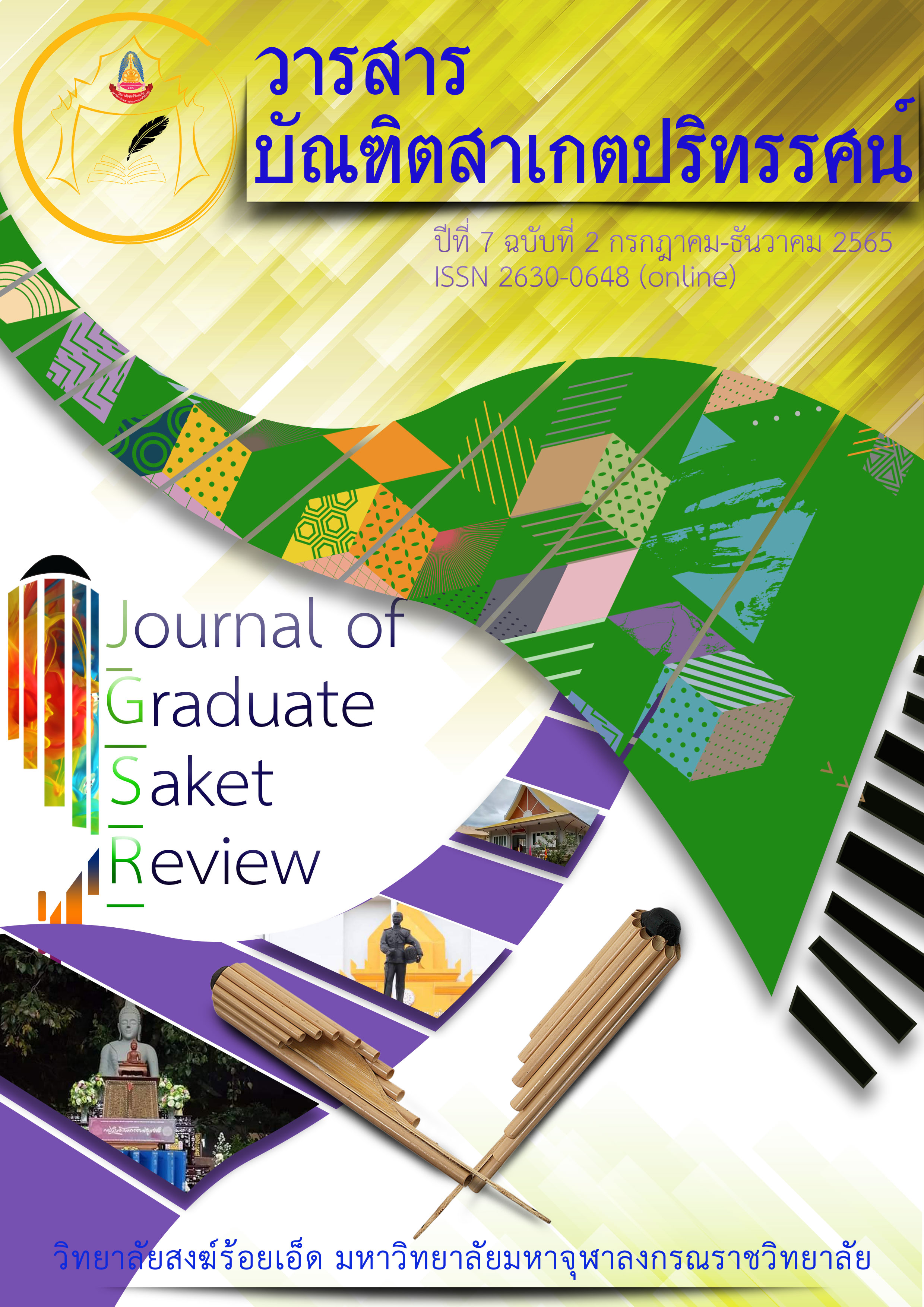ศึกษาคติความเชื่อที่ปรากฏในพิธีกรรมบุญแจกข้าวของชุมชนบ้านไผ่ อำเภอเชียงขวัญ จังหวัดร้อยเอ็ด
Main Article Content
บทคัดย่อ
บทความวิจัยนี้ มีวัตถุประสงค์คือ (1) ศึกษาสภาพปัจจุบันในการทำบุญแจกข้าวของชุมชนบ้านไผ่ ตำบลหมูม้น อำเภอเชียงขวัญ จังหวัดร้อยเอ็ด (2) ศึกษาคติความเชื่อในพิธีกรรมของการทำบุญแจกข้าวของชุมชนบ้านไผ่ ตำบลหมูม้น อำเภอเชียงขวัญ จังหวัดร้อยเอ็ด (3) เพื่อวิเคราะห์การเปลี่ยนแปลงคติความเชื่อในพิธีกรรมของการทำบุญแจกข้าวที่ส่งผลต่อวิถีชีวิตชุมชนบ้านไผ่ ตำบลหมูม้น อำเภอเชียงขวัญ จังหวัดร้อยเอ็ด
การวิจัยนี้ เป็นการวิจัยเชิงคุณภาพ (Qualitative Research) โดยศึกษาข้อมูลจากเอกสาร และการสัมภาษณ์ภาคสนาม
ผลจากการวิจัยพบว่า การทำบุญแจกข้าวของชาวบ้านไผ่ ตั้งแต่อดีตชาวบ้านไผ่ก็ประกอบพิธีทำบุญแจกข้าว เช่นเดียวกับชาวอีสานทั่วไปโดยจะทำอยู่ 3 วัน คือ วันเค้า วันโฮม และวันถวาย ปัจจุบันการประกอบพิธีเหลือ 1 วัน เพื่อประหยัดค่าใช้จ่าย และประหยัดเวลา
ความเชื่อของการทำบุญแจกข้าว หรือทำบุญหาคนตาย เป็นประเพณีความเชื่อของคนในชุมชนบ้านไผ่และชุมชนในอีสานที่ต้องการแสดงออกถึงความเคารพรักพ่อแม่และผู้ที่เสียชีวิตไปแล้ว เพื่อให้ดวงวิญญาณของผู้ล่วงลับสงบสุขและได้รับส่วนบุญที่ลูกหลานทำบุญหา และลูกหลานของผู้ล่วงลับก็ถือว่า เป็นการแสดงออกถึงความกตัญญู กตเวทิตา ต่อบรรพบุรุษของตน ซึ่งต้องทำบุญให้ทานผ่านสื่อ คือพระสงฆ์ ที่จะเป็นสื่อกลางส่งบุญไปให้แก่ผู้ที่ล่วงลับไปแล้ว เมื่อวิเคราะห์แล้ว ความเชื่อของชาวชุมชนบ้านไผ่ ก็มีความเชื่อเช่นเดียวกับชาวอีสานทั่วไป คือเมื่อตนเองได้ทำบุญแจกข้าวแล้ว ตนเองก็ได้ ให้ทาน รักษาศีล และเจริญจิตภาวนาด้วย การทำบุญที่จะให้ได้ผลบุญมากหรือผู้ที่ล่วงลับจะได้รับผลบุญนั้น มีหลักเกณฑ์อยู่ 3 ประการ คือ ผู้ให้ต้องเป็นผู้มีศีล ผู้รับก็เป็นผู้มีศีล ผู้ที่ล่วงลับไปอนุโมทนา ญาติผู้ล่วงลับก็จะได้รับผลบุญตามที่ลูกหลานทำบุญแจกข้าวอุทิศให้
Article Details

อนุญาตภายใต้เงื่อนไข Creative Commons Attribution-NonCommercial-NoDerivatives 4.0 International License.
เนื้อหาและข้อมูลในบทความที่ลงตีพิมพ์ในวารสารบัณฑิตสาเกตปริทรรศน์ ถือเป็นข้อคิดเห็นและความรับผิดชอบของผู้เขียนบทความโดยตรงซึ่งกองบรรณาธิการวารสาร ไม่จำเป็นต้องเห็นด้วย หรือร่วมรับผิดชอบใด ๆบทความ ข้อมูล เนื้อหา รูปภาพ ฯลฯ ที่ได้รับการตีพิมพ์ในวารสารบัณฑิตสาเกตปริทรรศน์ ถือเป็นลิขสิทธิ์ของวารสารบัณฑิตสาเกตปริทรรศน์ หากบุคคลหรือหน่วยงานใดต้องการนำทั้งหมดหรือส่วนหนึ่งส่วนใดไปเผยแพร่ต่อหรือเพื่อกระทำการใด ๆ จะต้องได้รับอนุญาตเป็นลายลักอักษรจากวารสารบัณฑิตสาเกตปริทรรศน์ ก่อนเท่านั้น
เอกสารอ้างอิง
ภาษาไทย
เสาวลักษณ์ อนันตศานต์. (2543). ทฤษฎีคติชนและวิธีการศึกษา. กรุงเทพมหานคร : สำนักพิมพ์รามคำแหง,
พระครูใบฎีกาเฉลิมพล อริยวํโส (คำเชื้อ). (2554). ศึกษาวิเคราะห์ปุพพเปตพลีที่ปรากฏในคัมภีร์ใบลานในล้านนา: กรณีศึกษาคัมภีร์เปตตพลีฉบับวัดหลวงราชสัณฐาน. วิทยานิพนธ์พุทธศาสตรมหาบัณฑิต. บัณฑิตวิทยาลัย: มหาวิทยาลัยจุฬาลงกรณราชวิทยาลัย.
มหามกุฏราชวิทยาลัย. (2543). ธัมมปทัฏฐกถาแปล ภาค ๑. กรุงเทพมหานคร: โรงพิมพ์มหามกุฏราชวิทยาลัย.
ภาษาอังกฤษ
Mahamakut Buddhist College. (2000). Dhammapadattakatha Translation, Part 1. Bangkok: Mahamakut Buddhist University.
Phrakru Baidikachalermphol Ariyawasso (Kham Chua). (2011). An Analytical Study of Puppetplee Appearing in Lanna Manuscripts: A Case Study of the Wat Luang Rajamorphaman Wat Luang Rajamorpha Edition of Pettplee Scriptures. M.A. Dissertation, Buddhist Studies, Mahachulalongkornrajavidyalaya University, Thailand.
Saowaluck Anantasant. (2000). Folklore Theory and Educational Methods. Bangkok: Ramkhamhaeng Publishing House.


